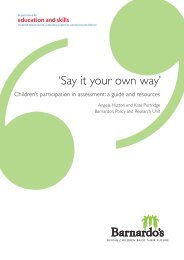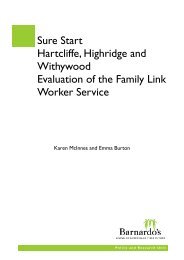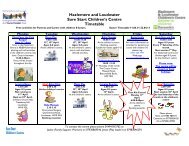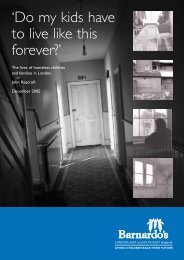Splintered Lives - Barnardo's
Splintered Lives - Barnardo's
Splintered Lives - Barnardo's
You also want an ePaper? Increase the reach of your titles
YUMPU automatically turns print PDFs into web optimized ePapers that Google loves.
PAGE 42<br />
chapter<br />
7<br />
(Wolpert Burgess et al, 1984) is presented. Creating a ring requires access to children,<br />
and this can occur through either the adult or one or more children. Initiation into the<br />
ring is usually careful and indirect, moving into pressure and coercion when required.<br />
Pornography frequently plays a part in the early stages of entrapment. Further<br />
strategies used to entrap children and maintain secrecy include; stressing the<br />
consequences for themselves and others if they tell; rewards including alcohol, money,<br />
drugs and cigarettes; valuable gifts; peer pressure, especially that others do not want to<br />
loose their 'rewards', and/or fear exposure too. Parents had range of responses to<br />
discovery of the abuse, as did the children. In three rings the offenders plea bargained<br />
offenses when the case came to court; a further two knew the police were involved and<br />
left town, and in one the two men skipped bail.<br />
In reporting on a later series of cases all 12 rings were found to have used adult<br />
pornography as instruction for the children and eight rings also produced it. Half of this<br />
eight sold material commercially, and children received some payment. For example:<br />
Pornographic materials found in the home of one 31 year old ring leader included<br />
videotapes of three teenage boys doing pornographic commercials, 22 photographs of<br />
a 10 year old boy undressing, and hundreds of photos of young boys kissing and<br />
fondling one another while dressed as women. (1984, p657)<br />
In this series more boys were abused than girls (49 compared to 17).<br />
The ongoing research resulted in a typology of sex rings, which has been used in<br />
subsequent work. The authors distinguish between solo rings (a single abuser and more<br />
than one child), transition rings (more than one abuser and more than one child) and,<br />
and syndicated rings (multiple abusers and many children with high levels of<br />
organisation and some commercial profit). In both transitional and syndicated rings<br />
connections between pornography and prostitution were evident.<br />
The authors also raise the following important point:<br />
We also suspect that incest and sex initiation rings increase the risk for the next level of<br />
ring operation, youth prostitution. Incest victims and children of sex ring<br />
victimization have learnt that sex involves an exchange process: thus, if money is<br />
needed, sex can be provided. (1981, p118)<br />
Further studies have also explored these connections. James and Myerling (1977)<br />
highlight the association for some young women between sexual abuse and adolescent<br />
prostitution; 65% of their sample of adolescents working as prostitutes had been sexually<br />
abused, and 85% of these incidents occurred before they were 16. They note:<br />
"early, traumatic sexual objectification may be one factor influencing some women<br />
toward entrance into prostitution" (p40). Mimi Silbert and Ayala Pines' research (1984)<br />
with 200 current and former sex workers in San Francisco, confirms this connection and<br />
extends it to include pornography. Just under two thirds of the women working<br />
currently in prostitution were 16 or under. The study used both questionnaires and more<br />
informal conversations. They comment that the study found:
















